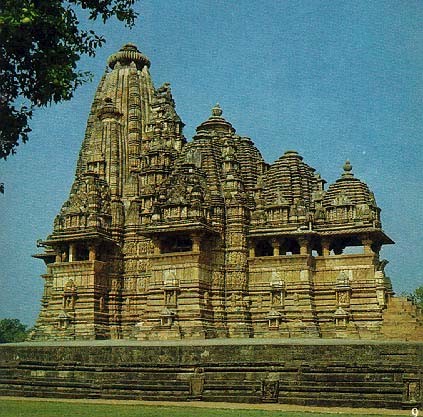
Introduction: Almost all Indian art has been religious, and almost all forms of artistic tradition have been deeply conservative. The Hindu temple developed over two thousand years and its architectural evolution took place within the boundaries of strict models derived solely from religious considerations. Therefore the architect was obliged to keep to the ancient basic proportions and rigid forms which remained unaltered over many centuries.
Even particular architectural elements and decorative details which had originated long before in early timber and thatch buildings persisted for centuries in one form or another throughout the era of stone construction even though the original purpose and context was lost. The horseshoe shaped window is a good example. Its origins lie in the caitya arch doorway first seen in the third century B.C. at the Lomas Rishi cave in the Barbar Hills. Later it was transformed into a dormer window known as a gavaksha; and eventually it became an element in a purely decorative pattern of interlaced forms seen time and time again on the towers of medieval temples. So, in its essence, Indian architecture is extremely conservative. Likewise, the simplicity of building techniques like post and beam and corbelled vaulting were preferred not necessarily because of lack of knowledge or skill, but because of religious necessity and tradition.
On the other hand, the architect and sculptor were allowed a great deal of freedom in the embellishment and decoration of the prescribed underlying principles and formulae. The result was an overwhelming wealth of architectural elements, sculptural forms and decorative exuberance that is so characteristic of Indian temple architecture and which has few parallels in the artistic expression of the entire worlds.
It is not surprising that the broad geographical, climatic, cultural, racial, historical and linguistic differences between the northern plains and the southern peninsula of India resulted, from early on, in distinct architectural styles. The Shastras, the ancient texts on architecture, classify temples into three different orders; the Nagara or ‘northern’ style, the Dravida or ‘southern ‘ style, and the Vesara or hybrid style which is seen in the Deccan between the other two. There are also dinsinct styles in peripheral areas such as Bengal, Kerala and the Himalayan valleys. But by far the most numerous buildings are in either the Nagara or the Dravida styles and the earliest surviving structural temples can already be seen as falling into the broad classifications of either one or the other.
In the early years the most obvious difference between the two styles is the shape of their superstructures.
Hi,
ReplyDeleteYour Collections are so beautiful...
You can update more and more things regarding religious....
Thanks!
RailJobs,
www.jobsrail.co.cc